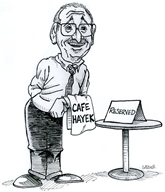Economic coordination isn’t a problem to be solved by computing an optimal answer. It emerges from the decentralized decisions and adjustments made by billions of economic actors—each with their own plans, preferences, and knowledge—in an ongoing, evolutionary process. Certain rules and institutions are essential for transforming decentralized decision-making into orderly and socially beneficial outcomes. The three Ps—property rights, prices, and profit and loss—provide the three Is—information, incentives and innovation.
“Prices enable people to engage in economic calculation, which forms the basis for the rational allocation of scarce resources among alternative ends. Prices also function as decentralized feedback loops. “A price is a signal wrapped up in an incentive,” note Tyler Cowen and Alex Tabarrok. This dual signal communicates information about relative scarcities and simultaneously encourages economic actors to adjust their plans accordingly. When lithium prices rise, producers and consumers conserve, recycle, innovate, and explore alternatives.
…..
AI’s economic champions confuse data processing with discovery and overlook how incentives shape the data AI receives. If political actors influence prices, then the input into algorithms is already distorted. “Garbage in, garbage out” still applies—only now the garbage is processed faster and packaged in technical jargon. AI may appear precise, but it has the same blind spots that doomed prior central planning efforts.
Centralizing decisions also distorts behavior. Entrepreneurs anticipating expropriation or opaque regulations may withdraw, reduce investment, or exit entirely. Consumers may hoard or barter. The very data planners rely on become unreliable as people adapt their behavior to avoid being captured by the system. Our research on post-socialist transitions shows that meaningful price signals only re-emerged after private exchange and budget discipline were restored. Computational power didn’t restore order—institutional reform did.
GMU Econ alum Jeremy Horpedahl looks carefully at the “China Shock.” Three slices:
Here’s a shocking fact: all of the MSAs [metropolitan statistical areas] hit hard by the China Shock still managed to have significant and positive real wage growth across the distribution since 2001, the earliest comparable data in the BLS OEWS data, conveniently timed at the beginning of the China Shock (note: for Cleveland, TN the data is first available in 2005, since it was not recognized as an MSA until 2003). Wage gains in several of these places, in fact, are better than the national trends.
…..
Perhaps wages are rising because people are dropping out of the labor force, thus artificially boosting the wages we observe in the OEWS data. That could be the case if the workers losing their jobs have below-average wages. When we look only at manufacturing jobs, all ten of these MSAs saw manufacturing employment fall since 2000, even though some of them saw recovery after the Great Recession. However, as we will see below, gains in jobs in other sectors offset those manufacturing job losses in almost all of these cities.
…..
As Adam Ozimek has recently pointed out, the resiliency of highly educated cities and commuting zones likely isn’t a coincidence or a mere correlation. It’s much more likely that it is a causal relationship, and there are good reasons a more-educated city would be better able to adapt to heavy exposure to the China Shock. So if there are policy implications to economically homogenous, lower-educated cities being less resilient in the face of an economic shock, it is that education and economic diversification would help, not trade barriers.
Scott Lincicome clarifies “the great tariff ‘inflation’ confusion.” Three slices:
One of this year’s more annoying yet persistent tariff defenses—including from a certain Oval Office Tariff Man and his trusty VP sidekick—is that tariffs can’t possibly be bad for American consumers or the U.S. economy because they haven’t caused “inflation.” In fact, a string of moderate 2025 reports from the two most common U.S. inflation gauges—the consumer price index (CPI) and the personal consumption expenditures price index (PCE)—have elicited victory laps from tariff defenders and even a detailed report from the President’s Council of Economic Advisers supposedly showing that the U.S. tariffs Trump imposed this year simply haven’t generated the “inflationary” pressures that tariff critics hysterically predicted. Tuesday’s new CPI print, which covered June and came in about where everyone was expecting, elicited more of the same, as did yesterday’s less-salient producer price index, which Vice President J.D. Vance jumped on to suggest “the economics profession doesn’t fully understand tariffs.”
So, has Trump proven the “experts” and “economists” wrong once again?
In short, no. Even leaving aside the wonky methodological mistakes (and blatant cherrypicking) that Vance and others tariff defenders have made, their recent “inflation” obsession reveals either a fundamental cluelessness about how tariffs and “inflation” interact—and about how most actual “economists” view the issue—or a cynical belief that you’re clueless, too.
…..
Put another way, global tariffs will increase the price level but not its rate of change (aka “inflation”)—at least not in the longer term. Thus, most economists expect the CPI or PCE to tick up this year because of Trump’s tariffs, but only temporarily. (In general, the widely held view among various professional economists is that we’ll see a gradual, 1-ish percentage point increase in the CPI and PCE figures, peaking later this year and early next but mostly subsiding after 2026.) Those higher prices still mean pain for American consumers, of course, but the increase wouldn’t technically be “inflation” as economists understand and define it. And any CPI uplift we do see in the coming year or so will pale in comparison with the recent post-pandemic inflation we’ve lived through, because imported goods are still relatively small shares of Americans’ total spending.
So, from a theoretical perspective, discussions of tariffs emphasizing their effect on the overall CPI number and “inflation” are mostly missing the boat. It’s an issue, especially given all the uncertainty right now, but it’s not the issue—and few serious economists have said otherwise. (Far more of them, in fact, have said just the opposite.)
…..
Then there’s the issue of foreign exporters eating the tariff costs by lowering their prices—Trump’s favorite excuse. As we’ve discussed, this is possible under the right circumstances but didn’t happen much during Trump 1.0, as American companies and consumers instead ate almost all of the tariffs’ costs. This time around, however, Goldman notes that there are some very early signs that foreign exporters, mainly Chinese, “have absorbed about 20% of the cost of tariffs”—an outcome that makes some sense given the sheer size of the tariffs, lingering inflation pain here, and widely reported deflationary problems in China. If these preliminary data hold, it’d be a shift from recent U.S. tariff experience but would still mean that Americans are paying about 80 percent of the tariffs’ cost—not exactly a huge Trump win. Other evidence, it should be noted, shows foreigners paying even less.
As tariffs really start to bite, the big questions will be whether foreign exporters keep eating some costs if it becomes clear tariffs are here to stay and how the remaining “80 percent” (or more) filters through the U.S. economy and into consumer prices—for both imports and domestic goods and services. And here, too, there are reasons to expect that the new costs won’t fully be evident in topline U.S. consumer price (inflation) data.
Yet Congress has never demanded a randomized, controlled trial to investigate whether Medicare and Medicaid improve health, much less conditioned their existence on two successful trials. One might think such measures are unnecessary. Subsidizing medicine delivers more health, right?
Not necessarily. Medicare and Medicaid impose rules that reduce healthcare quality. They increase prices for private-sector medical care and health insurance. They require taxes that reduce incomes, financial security and potentially economic growth. They have subsidy phaseouts that discourage upward mobility. Any health gains would have to overcome the health losses these factors introduce. It isn’t even clear whether the additional medical care that subsidies purchase improves health.
Multiple randomized, controlled trials examining subsidized medical care have failed to find health improvements. The Oregon Health Insurance Experiment measured the effects of giving Medicaid to the lowest earners among the able-bodied adults in ObamaCare’s Medicaid expansion population. Like other randomized trials, it found that subsidies led to additional medical care but no discernible improvements in physical health.
Failing to detect a relationship isn’t the same as proving that a relationship doesn’t exist. Many non-randomized studies that compare people with Medicare or Medicaid with people without it suggest those programs do save lives. On the other hand, the Oregon study’s more reliable design found that some non-randomized studies likely overstate Medicaid’s potential health effects, whether due to random chance or because they compare apples to oranges. Still other non-randomized trials cast doubt on Medicare and Medicaid’s effects on health, including one that found that Medicare had no discernible effect on elderly mortality, even after spending 10 years and $515 billion subsidizing healthcare for seniors.
Jacob Sullum looks at Trump’s defamation suit against the Wall Street Journal.
Skot Sheller reports that Javier Milei is serious about federalism.
David Henderson explains the power of thinking at the margin.



